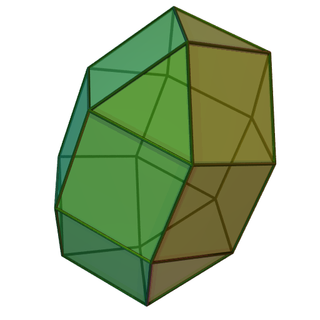Elongated triangular gyrobicupola
36th Johnson solid From Wikipedia, the free encyclopedia
In geometry, the elongated triangular gyrobicupola is a polyhedron constructed by attaching two regular triangular cupolas to the base of a regular hexagonal prism, with one of them rotated in . It is an example of Johnson solid.
Construction
The elongated triangular gyrobicupola is similarly can be constructed as the elongated triangular orthobicupola, started from a hexagonal prism by attaching two regular triangular cupolae onto its base, covering its hexagonal faces.[1] This construction process is known as elongation, giving the resulting polyhedron has 8 equilateral triangles and 12 squares.[2] The difference between those two polyhedrons is one of two triangular cupolas in the elongated triangular gyrobicupola is rotated in . A convex polyhedron in which all faces are regular is Johnson solid, and the elongated triangular gyrobicupola is one among them, enumerated as 36th Johnson solid .[3]
Properties
An elongated triangular gyrobicupola with a given edge length has a surface area by adding the area of all regular faces:[2] Its volume can be calculated by cutting it off into two triangular cupolae and a hexagonal prism with regular faces, and then adding their volumes up:[2]
Its three-dimensional symmetry groups is the prismatic symmetry, the dihedral group of order 12.[clarification needed] Its dihedral angle can be calculated by adding the angle of the triangular cupola and hexagonal prism. The dihedral angle of a hexagonal prism between two adjacent squares is the internal angle of a regular hexagon , and that between its base and square face is . The dihedral angle of a regular triangular cupola between each triangle and the hexagon is approximately , that between each square and the hexagon is , and that between square and triangle is . The dihedral angle of an elongated triangular orthobicupola between the triangle-to-square and square-to-square, on the edge where the triangular cupola and the prism is attached, is respectively:[4]
Related polyhedra and honeycombs
The elongated triangular gyrobicupola forms space-filling honeycombs with tetrahedra and square pyramids.[5]
References
External links
Wikiwand - on
Seamless Wikipedia browsing. On steroids.
















